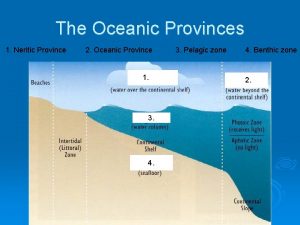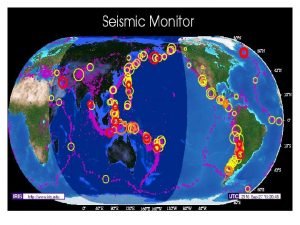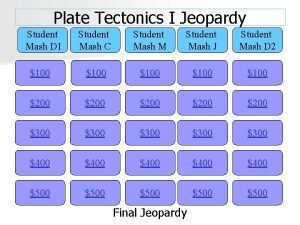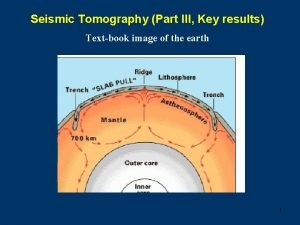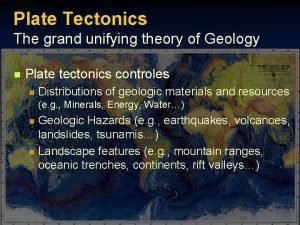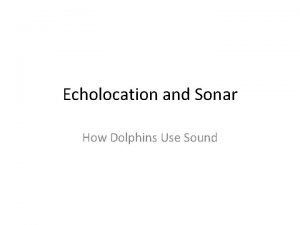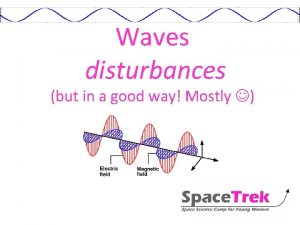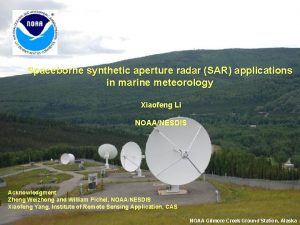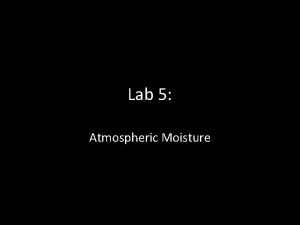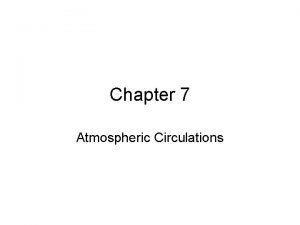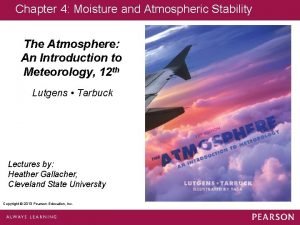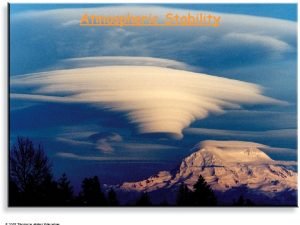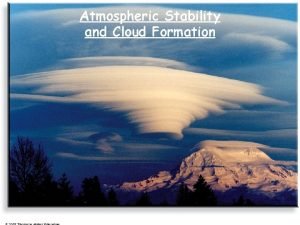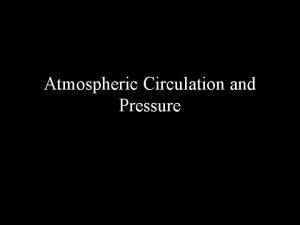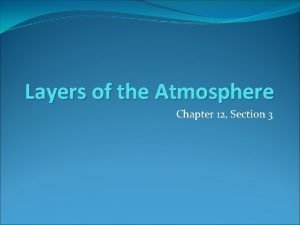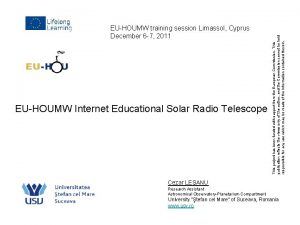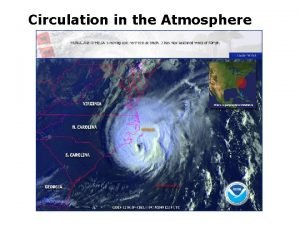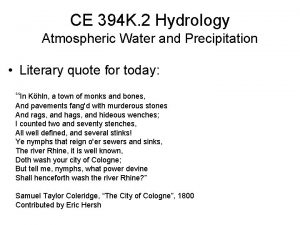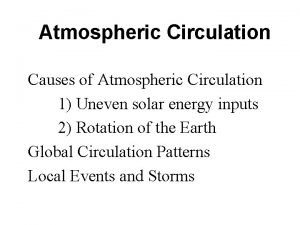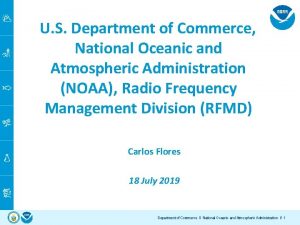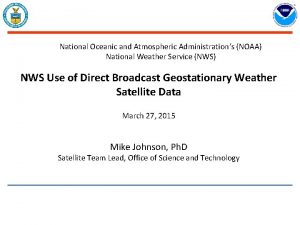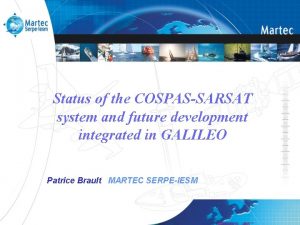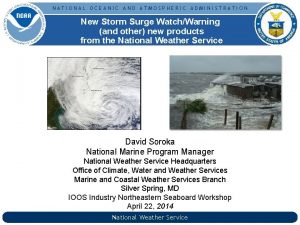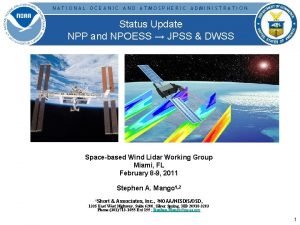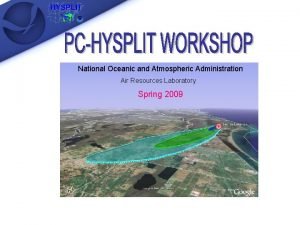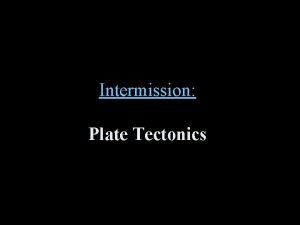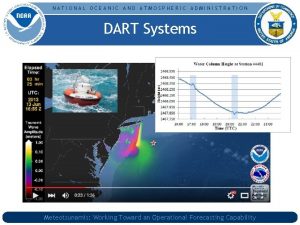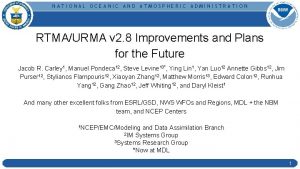CospasSarsat Department of Commerce National Oceanic and Atmospheric



























































- Slides: 59


Cospas-Sarsat Department of Commerce National Oceanic and Atmospheric Administration National Environmental Satellite, Data and Information Service Office of Satellite Data Processing and Distribution Direct Services Division

Cospas-Sarsat Cospas COsmicheskaya Systyema Poiska Aariynyich Sudov which translates loosely into “Space System for the Search of Vessels in Distress” Sarsat Search and Rescue Satellite Aided Tracking Cospas-Sarsat provides, free-of-charge, distress alert and location information to search and rescue authorities anywhere in the world for maritime, aviation and land users in distress.

Rescues Persons rescued world-wide since 1982 >11, 000 Persons rescued in United States since 1982 > 4, 000

History 1950 s– Concept of Doppler tracking developed to locate transmitters on earth surface using satellites 1960 s – Emergency beacons operating at 121. 5/243 MHz used by military 1972 – Congressmen Boggs and Begich lost in Alaska 1970 – Congress mandates carriage of 121. 5 ELT on general aviation aircraft 1967 – 16 -year old girl starves to death after waiting two months for rescue 1976 – Canada, France and United States begin development of the SARSAT program

History 1979 - Memorandum of Understanding among agencies in Canada, France, USA and former USSR 1983 - Launch of Sarsat-1 1988 - International Cospas. Sarsat Program Agreement signed by governments of Canada, France, USA and former USSR 1999 – C/S Phases out 121. 5/243 MHz 1998 - GEOSAR operational 1982 - Launch of Cospas-1, first save 1985 - Cospas-Sarsat declared operational 1992 - Russia assumes responsibilities for the former USSR

Cospas-Sarsat Program The following 28 countries are also formally associated with the Cospas-Sarsat Program as Ground Segment Providers or User States (two organizations in Hong Kong and Taipei also provide ground segment equipment): Algeria Chile Germany Indonesia Korea (Rep. of) New Zealand Peru Spain Switzerland United Kingdom Australia China (P. R. ) Greece Italy Madagascar Norway Saudi Arabia South Africa Thailand Brazil Denmark India Japan Netherlands (The) Pakistan Singapore Sweden Tunisia

Organization Cospas-Sarsat Council Program Management Joint Committee Cospas-Sarsat Secretariat Administrative Support System Operational Working Group Technical Working Group Exercise Working Group

International Cooperation International Maritime Organization UN specialized agency responsible for improving maritime safety (Mandates use of emergency beacons) International Civil Aviation Organization UN specialized agency responsible for aviation matters and improving civil aviation safety (Mandates use of 406 MHz beacons) International Telecommunications Union UN specialized agency responsible for coordinating global telecommunications (406 MHz beacon specifications)

System Operation GEO Satellites Local User Terminal Emergency Beacons Rescue Coordination Center Mission Control Center

Beacons Manual or Automatic Activation 121. 5/243 MHz Analog signal Approximately 600, 000 world-wide and 270, 000 in the United States 406 MHz Digital signal Approximately 225, 000 world-wide and 61, 000 in the United States Applications: Maritime - Emergency Position-Indicating Radio Beacon (EPIRB) Aviation - Emergency Locator Transmitter (ELT) Personal/Land - Personal Locator Beacon (PLB)

Satellites Two types of satellites: Low-earth orbiting (LEO)/polar orbiting (LEOSAR); and geosynchronous earth orbiting (GEO or GEOSAR)

Satellites LEO: United States NOAA/TIROS (121. 5, 243 and 406 MHz capability) - SARSAT Search and Rescue Repeater (SARR) - Canada Search and Rescue Processor (SARP) - France Russian Nadezda (121. 5 and 406 MHz capability) - COSPAS GEO: United States NOAA/GOES (406 MHz capability) Indian INSAT-2 B (406 MHz capability)

Satellites Satellite Spacecraft Status Cospas-4 Nadezda - 1 Operational Cospas-6 Nadezda - 3 Operational Cospas-8 Nadezda - 5 Operational Cospas-9 Nadezda-6 Operational Sarsat-4 NOAA-11 Operational Sarsat-6 NOAA-14 Operational Sarsat-7 NOAA-15 Operational Sarsat-8 NOAA-16 Operational GOES-8 Operational at 75 West GOES-10 Operational at 135 West GOES-11 In-orbit Spare INSAT-2 B Operational at 93. 5 East

Local Mode Operations (SARR) 121. 5 243 406 MHz

Global Mode Operations (SARP) 406 MHz

Local User Terminals LEOLUTs: Track Cospas and Sarsat satellites Recover beacon signals from satellites Perform bit error checking/correction on 406 MHz beacon messages Perform Doppler processing to determine geographic location Send resulting Doppler solutions to associated Mission Control Center

Local User Terminals GEOLUTs: Track GOES and INSAT satellites Recover beacon signals from satellites Perform bit error checking/correction on 406 MHz beacon messages Send resulting 406 MHz solutions to associated Mission Control Center

Local User Terminals 42 LEOLUT Sites

Local User Terminals 7 GEOLUTs

Local User Terminals Maryland California Guam Hawaii Texas Alaska United States LEOLUTs Puerto Rico

Local User Terminals United States LEOLUTs (Typical Configuration)

Local User Terminals United States Mobile LUT

Mission Control Center MCCs: Receive data from national LUTs and foreign MCCs Attempt to match signals coming from the same beacon source Merge beacon signals from the same source to improve location accuracy Geographically sort data to determine appropriate recipient of alert message Transmit alert messages to search and rescue authorities Filter redundant alert data Perform System support and monitoring functions

Mission Control Center 24 MCCs

United States Mission Control Center Communication Sites 14 LUTs Spacecraft Telemetry & Ephemeris Data 24 MCCs USMCC 7 SPOCs Special Programs 14 RCCs

United States Mission Control Center

United States Mission Control Center USMCC Activity (approximately): Handle 250 -400 121. 5/243 alerts/day Handle 10 -15 406 MHz alerts/day Schedule and ingest data from 500 satellite passes/day Transmit 1200 messages/day Register 30 new beacons/day Update 60 beacon registrations/day Confirm 300 beacon registrations/week Enter 35 incident feedback reports/day

Rescue Coordination Centers AKRCC CGD 9 CGD 17 CGD 13 AFRCC LANTAREA CGD 7 PACAREA CGD 14 CGD 8 GANTSEC Additional RCCs: MARSEC, PRCC, JRCC Southcom More

United States Cospas-Sarsat Program Inland SAR Maritime SAR Research & Development System Operation Representative to Cospas-Sarsat Program

United States Search and Rescue Program S vir atell on ite me Se nta rvi l In ces for , ma tio n En DOC s Se R SA ce i v r DOI SAR Facilities Research and Development dio a R DOD or f s on lities i t ula Faci g e SA R NASA Fa cil it ies R FCC DOT

System Performance Timing: Alert notification in 5 to 120 minutes depending on type of beacon, location and satellite configuration Accuracy: 100 meters to 20 kilometers depending on type of beacon Reliability: Depends on type of beacon

Problems 121. 5/243 MHz Satellite Alerting System Inefficient Numerous false alerts No identification information available Unreliable alerts (often originate from non-beacon sources) False Alerts Diminishes integrity of System Wastes SAR resources Possibly diverts SAR resources from actual distress Interference in Frequency Band Masks real distress signals

More Information For more information visit the following web sites: http: //www. sarsat. noaa. gov/ http: //www. cospas-sarsat. org/ http: //www. uscg. mil/hq/g-opr/sar. htm http: //www. acc. af. mil/afrcc/ http: //poes 2. gsfc. nasa. gov/sar. htm

SARSAT Payload Description

SARSAT Payload SLA 1544. 5 MHz Antenna SRA 121/243 MHz Antenna DCS/UDA 406/401 MHz Antenna SRA 406 MHz Antenna SARSAT Antennas Diplexer Filter 1544. 5 MHz Transmitter Diplexer Filter 121. 5 MHz Rx 243 MHz Rx Filter 406 MHz Rx 406. 050 MHz Search and Rescue Processor (SARP-2) 2. 4 Kbps Data Search and Rescue Repeater (SARR) Power Command Telemetry S/C Interface Power Command Telemetry DCS/2

SARSAT SARP-2 Description DRU-3 Receiver DRU-2 Distributor Control Unit Phase-Lock Loop USO Power Interface TM Synchro Bit SPU Interface Logic Unit Sequencer Interface CD Receiver Power Unit (RPU) Spectr. Analys. DRU-1 Doppler Measurer Formatter Memory Clock Signal Processing Unit (SPU) Spacecraft Interface

SARP-x Description • Receives and processes the 406 MHz distress beacons transmissions : – Measures the received frequency (accuracy 0. 2 Hz) – Time tags the frequency measurement (accuracy 1 ms) – Demodulates the message content (down to 34 d. B. Hz) • Format and store the above information. • Send to the SARR 1544. 5 MHz transmitter the Processed Data Stream (PDS) consisting of real time and play back data.

SARP-x Description • Input bandwidth : 406. 01 MHz / 406. 09 MHz (80 k. Hz) • Two types of beacon periodic messages (50 s) : – short message : 0. 44 s 400 bps – long message : 0. 52 s 400 bps • Capacity : the present SARP-3 can receive and process 95% of the messages transmitted by 50 distress beacons simultaneously active in the satellite visibility circle.

SARP-x Description • The present SARP-2 and SARP-3 memory size is 2048 messages. SARP-3 memory may be increased by ground command up to 2560 messages. • Beacon messages are transmitted to SARR as soon as received and processed (real time). • Most recent messages is stored in place of the oldest one in the memory. • Memory is read in LIFO continuously when there is no real time messages to be transmitted (play-back).

SARP-x Description • Fully redundant • One unit* : Receiver-Processor Unit : RPU • Receive antenna at 401 MHz and filters, also used on Tiros for the Argos-DCS, may be used on NPOES for the SARP and the Search and Rescue Repeater (SARR). • Mission data are sent to the SARR * an extra unit may be needed to adapt the A-DCS and SARP-3 Tiros interfaces to the NPOESS (TBC).

SARP-x Mechanical Interfaces SARP-xx Length (u) Width (v) Height (w) Mass (*) Recever Processing Unit (RPU) 365 mm 280 mm 195 mm 18 kg DCS Interface Unit (**) (DIU) TBC 288 mm 210 mm 63 mm 4 kg (*) : without harness (**) : may be shared with A-DCS (TBC)

SARP-x Electrical Interfaces • • • Power consumption Pulse discrete commands Level discrete commands Digital HK telemetry Analog TM channels 35 watts 12 PDC 7 LDC + strobe 15 TM points 20 TM channels • SARP-3 mission and instrument design are dated 1999. • One cannot exclude some evolution between now and the N-POES SARP-xx actual development. • Technology evolution should be transparent for the satellite.

SARP-x Electrical Interfaces N-POESS satellite Receive antenna 401 MHz/406 MHz SARP-xx instrument SARP Interface Unit (TBD) Cd and HK TM RF accommodation hardware SARP DCS SARR ? power Mission data Receiver Processor Unit (RPU) side A side B SARR Transmitter Unit side A side B Transmit antenna 1544. 5 MHz

SARP-x Electrical Interfaces N-POESS satellite Receive antenna 401 MHz/406 MHz SARP-xx instrument SARP Interface Unit (TBD) Cd and HK TM RF accommodation hardware SARP DCS SARR ? power Mission data Receiver Processor Unit (RPU) side A side B SARR Transmitter Unit side A side B Transmit antenna 1544. 5 MHz

SARR • • Fully redundant Total size Total weight Total power consumpiton 1. 6 cubic feet 45 pounds 47 watts

SARR Description

SARR Receiver Description

SARR - Transmitter

SARR - Transmitter Sarsat SARR Baseband Frequency Spectrum 121. 5 MHz Baseband 2. 4 kbps PDS Baseband 0 406 MHz Baseband 243 MHz Baseband 6 d. B -10 -20 -30 Relative Level of Integrated Power in Each Band (d. B) 5. 0 2. 4 34. 5 59. 5 47. 0 71. 0 117. 0 94. 0 130. 0 210. 0 170. 0 Baseband Frequency in k. Hz Note: Drawing not to scale and bandwidths given are 1 d. B bandwidths

SARSAT Telemetry & Commanding

SARP-2 (Analog Telemetry) Temperature: Receiver Processer Unit USO Thermal Regulation SPU Box Converter Power: SARP Converter +5 v, -5 v SARP Converter +12 v, -12 v SARP Converter +28 v Main Bus voltage

SARR (Analog Telemetry) Transmitters: Current (A/B side) Output Power (A/B side) Temperature (A/B side) Baseplate Temperature Receivers: AGC (121. 5/243/406) (A/B side) Temperature (121. 5/406) (A/B side) Power Telemetry and Command: Temperature (A/B side) 28 Volt monitor 16 Volt monitor (A/B side)

SARP (Digital Telemetry) SARP Relay A Status SARP Relay B Status DRU 1/2/3 Status SARP Time Clock Pseudo-Message Memory ON/OFF Read Continuously Read Single Shot Read/erase Single Shot Receiver Bandwidth 1 (406. 01 – 406. 09) Receiver Bandwidth 2 (406. 01 – 406. 05) Receiver Bandwidth 3 (406. 01 – 406. 037)* * Probably wont be available in SARP-x

SARR (Digital Telemetry) SARR 121. 5 Redundancy Switch SARR 243 MHz Redundancy Switch SARR 406 MHz Redundancy Switch SARR Tx Ouput RF Redundancy Switch

Telemetry Processing NOAA CDA Digital Telemetry Count SOCC Take Appropriate Action NOAA SOCC/IPD Digital Telemetry Count Engineering Units Telemetry Volts USMCC CMCC FMCC DND CNES

Commands SARR: Enable/disable Select Side (A/B) Change modulation index (Rx Attenuations) Receiver Gain Mode (Fixed or AGC) SARP: Enable/disable (SARP, DRUs, Pseudo-mode) Memory Commands Bandwidth Selection

Monitoring/Commanding Consultation SPE CMCC C/S Ground Segment, USMCC, SOCC Commands USMCC SOCC Notification to Cospas-Sarsat Verification USMCC Consultation FMCC SPE

Coordination International Cospas-Sarsat Programme Agreeement Supports SARSAT Memorandum of Agreement National Search and Rescue Committee Supports SARSAT Project Plan Telemetry and Command Procedures Supports National Search and Rescue Plan Interagency Memorandum of Agreement Cospas-Sarsat Program Plan Letters of Agreement
 Convergent oceanic oceanic plate boundary
Convergent oceanic oceanic plate boundary Convergent continental boundary
Convergent continental boundary Location-based commerce (l-commerce)
Location-based commerce (l-commerce) Department of commerce and consumer affairs
Department of commerce and consumer affairs Neritic province and oceanic province
Neritic province and oceanic province Neritic zone climate
Neritic zone climate Picture of alfred wegener
Picture of alfred wegener Continental and oceanic crust
Continental and oceanic crust National risk and resilience ambulance
National risk and resilience ambulance Mountain plates
Mountain plates Divergent boundry
Divergent boundry 15.3 oceanic productivity
15.3 oceanic productivity Sunlight zone animals
Sunlight zone animals Oceanic divisions
Oceanic divisions New york oceanic
New york oceanic Oceanic crust vip #1
Oceanic crust vip #1 7 lithospheric plates
7 lithospheric plates Oceanic group of companies
Oceanic group of companies Happens when two oceanic plates collide
Happens when two oceanic plates collide The cross section below depicts magnetized oceanic crust
The cross section below depicts magnetized oceanic crust Convergence of two oceanic plates oreo
Convergence of two oceanic plates oreo Texbook
Texbook Oceanic crust age
Oceanic crust age Mid oceanic ridge
Mid oceanic ridge Oceanic airlines 777
Oceanic airlines 777 Harry hess and seafloor spreading
Harry hess and seafloor spreading Types of plate boundaries
Types of plate boundaries Oceanic plate
Oceanic plate Tuna food web
Tuna food web Oceanic plate
Oceanic plate Sonar and echolocation
Sonar and echolocation Which part of the earth is the hottest?
Which part of the earth is the hottest? Oceanic food web
Oceanic food web Climat de tranzitie
Climat de tranzitie Cithosphere
Cithosphere Atmospheric opacity
Atmospheric opacity Atmospheric perspective watercolor
Atmospheric perspective watercolor Atmospheric suits
Atmospheric suits Atmospheric gravity waves
Atmospheric gravity waves Penn state atmospheric science
Penn state atmospheric science Lab 5 atmospheric moisture
Lab 5 atmospheric moisture Atmospheric pressure at different altitudes
Atmospheric pressure at different altitudes Forceparcel
Forceparcel Single cell model of atmospheric circulation
Single cell model of atmospheric circulation Atmospheric stability
Atmospheric stability Unstable equilibrium
Unstable equilibrium Conditionally unstable atmosphere
Conditionally unstable atmosphere Single cell model of atmospheric circulation
Single cell model of atmospheric circulation Stellar heaven
Stellar heaven Section 1 atmospheric basics continued answers
Section 1 atmospheric basics continued answers Atmospheric opacity
Atmospheric opacity Atmospheric circulation
Atmospheric circulation Atmospheric distortion correction
Atmospheric distortion correction What are weather variables
What are weather variables Atmosphere layers definition
Atmosphere layers definition Biomes
Biomes A first course in atmospheric thermodynamics solutions
A first course in atmospheric thermodynamics solutions Atmospheric convection
Atmospheric convection Atmospheric convection
Atmospheric convection Atmospheric convection
Atmospheric convection




